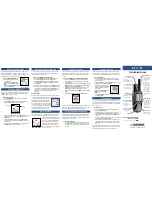
your scanner. This automatically disconnects the internal speaker.
Listening Safely
To protect your hearing, follow these guidelines when you use an earphone
or headphones:
Do not listen at extremely high volume levels. Extended high-volume
listening can lead to permanent hearing loss.
Set the volume to the lowest sett ing before you begin listening.
After you begin listening, adjust the volume to a comfortable level.
Once you set the volume, do not increase it. Over time, your ears adapt
to the volume level, so a volume level that does not cause discomfort
might still damage your hearing.
Traffic Safety
Do mot use an earphone of headphones with your scanner when operating a
motor vehicle in or near traffic. Doing so can create a traffic hazard
and could be illegal in some areas.
If you use an earphone or headphones with your scanner while operating
a motor vehicle, be very careful. Do not listen to a continuous
broadcast. Even though some earphones/headphones let you hear some
outside sounds when listening at normal volume level s, they still can
present a traffic hazard.
CONNECTING AN EXTENSION SPEAKER
In a noisy area, an extension speaker (Cat. No. 21 -549) or an amplified
speaker (Cat. No. 21 -541) might provide more comfortable listening.
Plug the speaker cable's 1/8 -inch mini-plug into the EXT SPKR jack on the
back of your scanner.
UNDERSTANDING YOUR SCANNER
Once you understand a few simple terms we use in this manual and
familiarize yourself with your scanner's features, you can put the
scanner to work for you. You simply determine the communications you
want to receive, then set the scanner to scan those frequencies.
A frequency is the turning location of a station (expressed in kHz or
MHz). To find active frequencies, you can use the search function to
search bands, which are preset ranges of frequencies.
When you find a frequency, you can store it into a permanent memory
location called a channel, which is grouped with your other channels
in a channel-storage bank. You can then scan the channel -storage banks
to see if there is activity on the frequencies stored there. Each time
the scanner finds an active frequency, it stays on that channel until the
transmission ends.
Another option is to store the frequency into a temporary memory location
called a monitor memory until you decide to move it to a channel.
















































